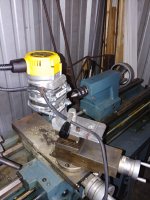I agree about the point loading and alignment issues of that config. Have been suggesting just offset bore the damn mount to fit. If that is scary, offset bore a pad and add it with a couple screws. He's got a lathe if not a mill, what is the resistance to a little simple machine work that easily improves the tools? All kinds of work arounds that take more effort than a simple fix.
:banghead:
Rant, grumble, grumble, etc,
:grin-square:
But as accepted after his second iteration - looks stable enough at this point, at least a great improvement. If he has a lathe and no tooling, wad of fiber filler suggestion might at least be accessible.
If it repeats, we're wrong. If it does not repeat over time, the message from the universe will eventually become clearer.

smt
